Clean Sink Naturally 鈥?sounds like a dream, right? I know, I know, staring at a grimy sink is nobody’s idea of a good time. But what if I told you that you could ditch those harsh chemicals and achieve a sparkling clean sink using ingredients you probably already have in your pantry?
For generations, resourceful homemakers have relied on natural remedies to keep their homes clean and fresh. Think about it 鈥?before the age of mass-produced cleaning products, things like vinegar, baking soda, and lemon juice were the go-to solutions for everything from scrubbing floors to deodorizing refrigerators. This tradition of using natural ingredients to clean sink naturally is not only effective but also kinder to our planet and our health.
Let’s face it, our sinks endure a lot. From food scraps and coffee grounds to toothpaste and who-knows-what-else, they’re a breeding ground for bacteria and unpleasant odors. Nobody wants that! That’s why I’m so excited to share these simple, yet powerful, DIY tricks that will transform your sink from a source of stress to a sparkling centerpiece of your kitchen or bathroom. Get ready to say goodbye to stubborn stains and hello to a naturally clean and fresh sink!
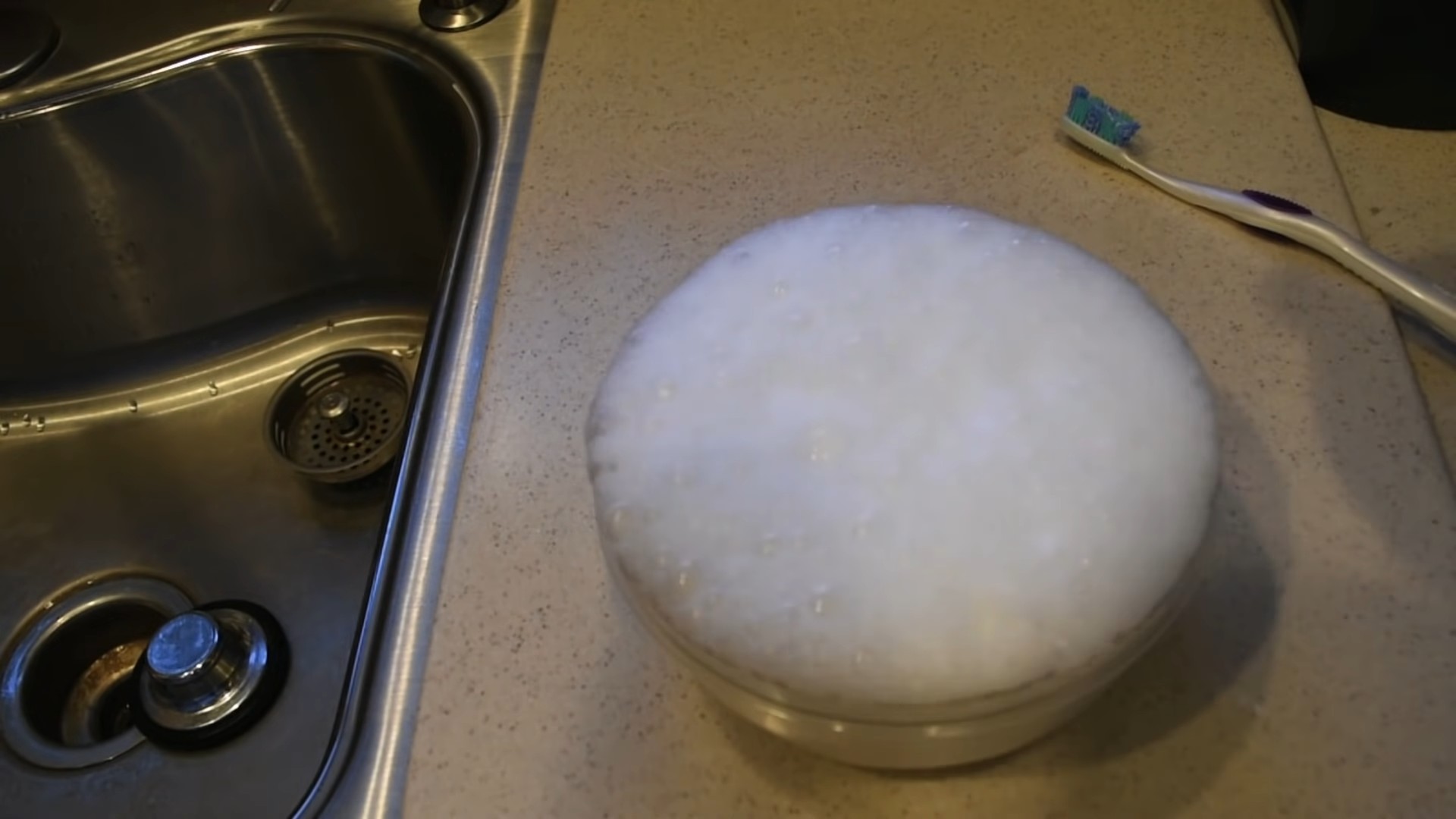
DIY Natural Sink Cleaning Powerhouse
Hey everyone! I’m so excited to share my go-to method for keeping my sink sparkling clean without relying on harsh chemicals. This DIY cleaner is super effective, budget-friendly, and uses ingredients you probably already have in your pantry. Let’s ditch the store-bought stuff and get our sinks looking brand new, naturally!
What You’ll Need: The Arsenal of Clean
Before we dive in, let’s gather our supplies. This is a pretty simple recipe, so you won’t need much:
* Baking Soda: This is our gentle abrasive and deodorizer.
* White Vinegar: The acid helps cut through grease and grime.
* Lemon (optional, but highly recommended): Adds a fresh scent and extra cleaning power.
* Dish Soap (natural, if possible): For extra degreasing.
* Salt (coarse is best): Another gentle abrasive.
* Boiling Water: Helps loosen stubborn dirt and sanitize.
* Old Toothbrush or Scrub Brush: For getting into those hard-to-reach spots.
* Microfiber Cloth: For wiping everything down.
* Rubber Gloves (optional): To protect your hands.
* Spray Bottle (optional): For easier vinegar application.
Step-by-Step Sink Cleaning Guide
Alright, let’s get down to business! Follow these steps for a squeaky-clean sink:
1. Clear the Decks: First things first, remove everything from your sink 鈥?dishes, sponges, soap dispensers, the whole shebang. We need a clear workspace to work our magic.
2. The Baking Soda Blanket: Generously sprinkle baking soda all over the sink surface, including the basin, drain, and faucet. Don’t be shy! You want a good, even coating. I usually use about half a cup, but adjust as needed depending on the size of your sink.
3. Vinegar Volcano (The Fun Part!): Now, slowly pour white vinegar over the baking soda. Get ready for some fizzing action! This is the chemical reaction that helps loosen dirt and grime. Let it bubble and work its magic for about 5-10 minutes. The amount of vinegar depends on the size of your sink. I usually use about a cup.
4. Scrub-a-Dub-Dub: Grab your old toothbrush or scrub brush and start scrubbing! Pay special attention to areas with stubborn stains, water spots, or around the drain. The baking soda acts as a gentle abrasive, helping to lift away the dirt. Don’t forget to scrub around the faucet base and handles 鈥?those areas tend to accumulate grime.
5. Salt Power Scrub (For Extra Oomph): If you have some particularly stubborn stains, sprinkle a bit of coarse salt onto your scrub brush and give those areas an extra scrub. The salt provides a little more abrasive power without being too harsh.
6. Lemon Freshness (Optional, but Awesome): If you’re using a lemon, cut it in half and use it to scrub the sink. The lemon juice adds extra cleaning power and leaves a wonderful fresh scent. You can also squeeze some lemon juice directly onto stubborn stains and let it sit for a few minutes before scrubbing.
7. Dish Soap Boost: Add a squirt of dish soap to your scrub brush and give the entire sink another scrub. This helps to degrease and remove any remaining residue.
8. Boiling Water Rinse: Carefully pour boiling water down the drain. This helps to flush away any remaining debris and sanitize the drain. Be careful not to splash yourself with the boiling water!
9. Final Rinse and Shine: Rinse the entire sink thoroughly with warm water. Make sure to remove all traces of baking soda, vinegar, and dish soap.
10. Dry and Buff: Use a clean microfiber cloth to dry the sink completely. Buffing the surface will help to prevent water spots and leave your sink looking extra shiny.
Tackling Specific Sink Issues
Sometimes, your sink might have specific problems that need a little extra attention. Here are a few tips for dealing with common sink issues:
Stubborn Stains
For tough stains, make a paste of baking soda and water. Apply the paste to the stain and let it sit for 15-20 minutes before scrubbing. You can also try using a lemon wedge to scrub the stain.
Hard Water Spots
Hard water spots can be a real pain. To remove them, soak a paper towel in white vinegar and place it over the water spots. Let it sit for about an hour, then scrub and rinse.
Clogged Drain
If your drain is clogged, try pouring a cup of baking soda down the drain, followed by a cup of white vinegar. Let it fizz for 30 minutes, then flush with boiling water. You can also use a drain snake to remove any physical blockages.
Smelly Drain
A smelly drain is usually caused by a buildup of food particles and bacteria. To freshen it up, pour a cup of baking soda down the drain, followed by a cup of white vinegar. Let it fizz for 30 minutes, then flush with boiling water. You can also drop a few lemon or orange peels down the drain and run the garbage disposal (if you have one).
Maintaining Your Sparkling Sink
Once you’ve got your sink clean, it’s important to maintain it to prevent future buildup. Here are a few tips:
* Rinse After Use: After each use, rinse the sink thoroughly with water to remove any food particles or soap residue.
* Wipe Down Regularly: Wipe down the sink with a microfiber cloth after each use to prevent water spots and buildup.
* Weekly Deep Clean: Give your sink a deep clean using the method described above at least once a week.
* Avoid Harsh Chemicals: Harsh chemicals can damage your sink and are not necessary for effective cleaning. Stick to natural cleaning methods whenever possible.
* Don’t Pour Grease Down the Drain: Grease can clog your drain and cause unpleasant odors. Dispose of grease properly in the trash.
Why This Method Works (The Science Behind the Sparkle)
So, why does this natural cleaning method work so well? Let’s break it down:
* Baking Soda: A mild abrasive that helps to scrub away dirt and grime without scratching the sink surface. It’s also a natural deodorizer, helping to eliminate unpleasant odors.
* White Vinegar: An acid that helps to dissolve grease, grime, and hard water stains. It also has antibacterial properties.
* Lemon: Contains citric acid, which is a natural cleaning agent and deodorizer. It also leaves a fresh, clean scent.
* Dish Soap: Helps to degrease and remove any remaining residue.
* Salt: Provides extra abrasive power for tackling stubborn stains.
* Boiling Water: Helps to loosen stubborn dirt and sanitize the drain.
By combining these ingredients, you create a powerful cleaning solution that is both effective and environmentally friendly.
A Few Extra Tips and Tricks
* For stainless steel sinks, always scrub in the direction of the grain to avoid scratching.
* If you have a porcelain sink, be careful not to use abrasive cleaners, as they can damage the surface.
* To prevent water spots, dry your sink thoroughly after each use.
* You can also use this method to clean other surfaces in your kitchen, such as countertops and stovetops. Just be sure to test it in an inconspicuous area first to make sure it doesn’t damage the surface.
* If you have a garbage disposal, run it regularly with cold water to prevent buildup and odors.
I hope you found this DIY sink cleaning guide helpful! Give it a try and let me know what you think. I’m confident that you’ll be amazed at how clean and shiny your sink can be without using harsh chemicals. Happy cleaning!
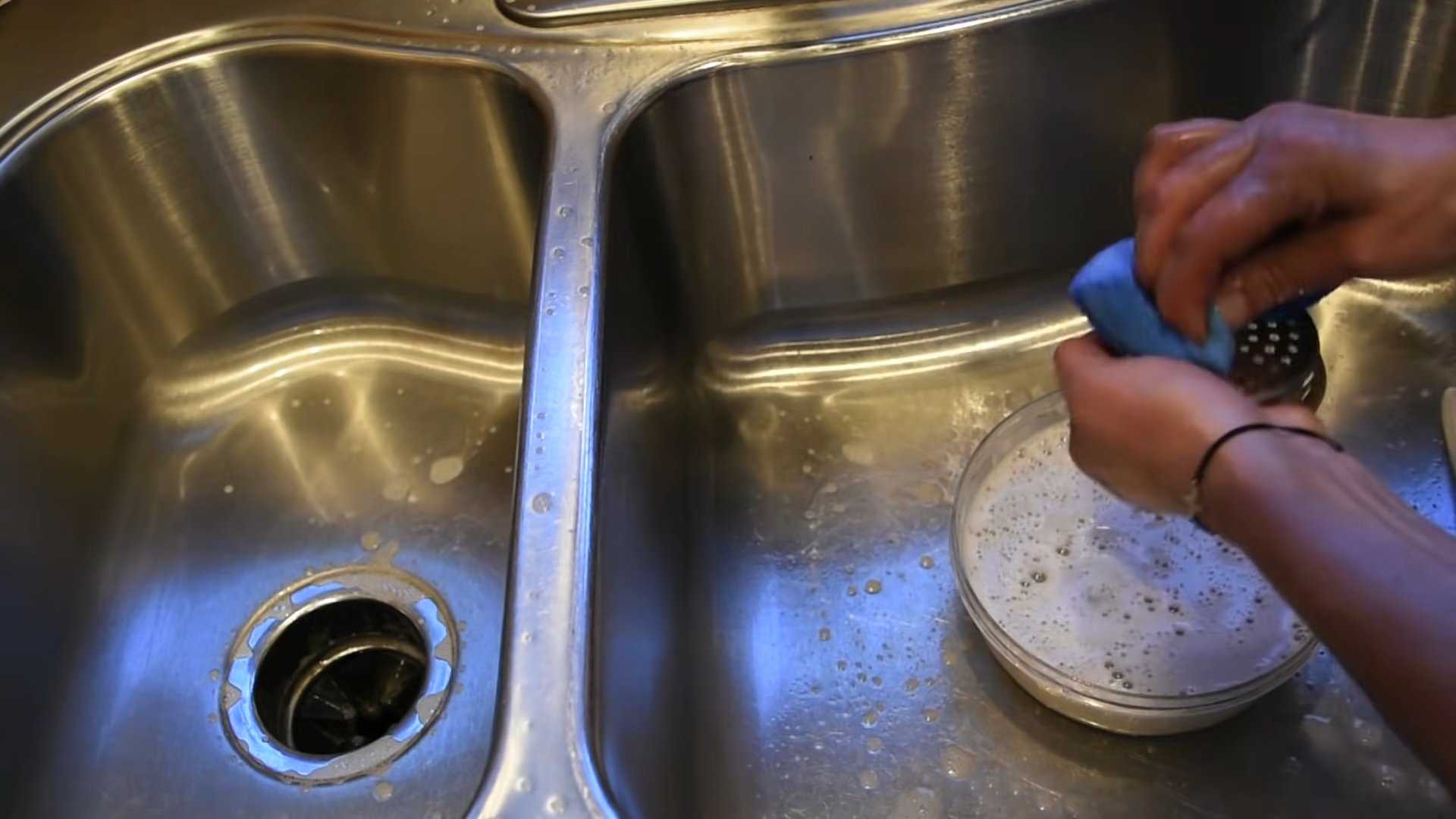
Conclusion
So, there you have it! A simple, effective, and eco-friendly way to clean sink naturally, banishing harsh chemicals from your home and saving you money in the process. This isn’t just about cleaning; it’s about embracing a more sustainable lifestyle, one sparkling sink at a time.
Why is this DIY trick a must-try? Because it works! The combination of baking soda and vinegar creates a powerful fizzing action that loosens grime, neutralizes odors, and leaves your sink gleaming. Plus, you likely already have these ingredients in your pantry, making it incredibly convenient and cost-effective. Forget those expensive, store-bought cleaners filled with questionable chemicals. This method is gentle on your sink, tough on dirt, and kind to the environment.
But the best part? It’s adaptable! Feel free to experiment with variations to suit your specific needs and preferences. For a boost of freshness, add a few drops of your favorite essential oil, like lemon, tea tree, or eucalyptus, to the baking soda before adding the vinegar. These oils not only smell amazing but also possess antibacterial properties, further enhancing the cleaning power. If you’re dealing with stubborn stains, create a paste of baking soda and water and let it sit on the affected area for a few minutes before scrubbing. For extra scrubbing power, use an old toothbrush or a non-scratch scouring pad.
Another variation involves using lemon juice instead of vinegar. Lemon juice is a natural disinfectant and has a pleasant citrusy scent. Simply sprinkle baking soda into the sink, then pour lemon juice over it. Let it fizz for a few minutes, then scrub and rinse. This is a great option if you’re sensitive to the smell of vinegar.
For stainless steel sinks, be sure to rinse thoroughly after cleaning to prevent water spots. You can also polish the sink with a microfiber cloth to restore its shine. For porcelain sinks, avoid using abrasive cleaners or scouring pads, as they can scratch the surface.
We’re confident that once you try this DIY method to clean sink naturally, you’ll be amazed by the results. It’s a simple, effective, and sustainable way to keep your sink sparkling clean without harming the environment or your wallet.
So, what are you waiting for? Give it a try! We encourage you to embrace this natural cleaning solution and experience the difference for yourself. And most importantly, we want to hear about your experience! Share your tips, variations, and before-and-after photos in the comments below. Let’s build a community of eco-conscious cleaners and inspire others to ditch the chemicals and embrace the power of natural ingredients. Your feedback will help us refine this method and make it even better for everyone. Let us know if you have any questions, and happy cleaning!
Frequently Asked Questions (FAQ)
1. Is baking soda and vinegar safe for all types of sinks?
Generally, yes, baking soda and vinegar are safe for most common sink materials like stainless steel, porcelain, and composite. However, it’s always a good idea to test a small, inconspicuous area first, especially if you have a more delicate or antique sink. Avoid using abrasive scrubbers on porcelain sinks, as they can scratch the surface. For stainless steel, ensure you rinse thoroughly to prevent water spots. If you have a sink made of a less common material, consult the manufacturer’s instructions before using this method.
2. How often should I clean my sink using this method?
The frequency depends on how often you use your sink and how dirty it gets. For general maintenance, cleaning your sink with baking soda and vinegar once or twice a week is usually sufficient. If you notice stubborn stains or odors, you may need to clean it more frequently. Regular cleaning will prevent buildup and keep your sink looking its best.
3. Can I use this method to unclog a slow-draining sink?
Yes, this method can help unclog a slow-draining sink. The fizzing action of baking soda and vinegar can help break down grease and debris that are causing the blockage. Pour a cup of baking soda down the drain, followed by a cup of vinegar. Let it fizz for 30 minutes, then flush with hot water. You may need to repeat this process a few times for stubborn clogs. For severe clogs, you may need to use a plunger or call a plumber.
4. What if I don’t have vinegar? Can I use something else?
If you don’t have vinegar, you can use lemon juice as a substitute. Lemon juice is a natural disinfectant and has a pleasant citrusy scent. Simply sprinkle baking soda into the sink, then pour lemon juice over it. Let it fizz for a few minutes, then scrub and rinse. You can also use a store-bought citric acid solution, diluted according to the product instructions.
5. The vinegar smell is too strong for me. How can I minimize it?
The vinegar smell can be strong, but it dissipates quickly. To minimize the odor, you can add a few drops of your favorite essential oil, like lemon, lavender, or eucalyptus, to the baking soda before adding the vinegar. You can also open a window or turn on the exhaust fan to ventilate the area. Another option is to use lemon juice instead of vinegar, as it has a more pleasant scent.
6. What kind of baking soda and vinegar should I use?
Regular baking soda (sodium bicarbonate) and white distilled vinegar are the most common and effective options for cleaning your sink. You don’t need to use expensive or specialized products. Just make sure the baking soda is fresh and the vinegar is not expired.
7. Can I use this method to clean other areas of my kitchen?
Yes, the baking soda and vinegar cleaning method can be used to clean other areas of your kitchen, such as countertops, stovetops, and even the inside of your refrigerator. However, always test a small, inconspicuous area first to ensure it doesn’t damage the surface. Avoid using this method on delicate surfaces like marble or granite, as the vinegar can etch the stone.
8. How do I get rid of hard water stains in my sink?
Hard water stains can be difficult to remove. To tackle them, soak a paper towel in vinegar and place it over the stained area for a few hours or overnight. The vinegar will help dissolve the mineral deposits. Then, scrub the area with baking soda and rinse thoroughly. You may need to repeat this process a few times for stubborn stains. You can also use a commercial hard water stain remover, following the product instructions carefully.
9. My sink has a garbage disposal. Is this method safe for it?
Yes, this method is generally safe for garbage disposals. In fact, it can help freshen and clean your garbage disposal. After cleaning your sink, pour the baking soda and vinegar mixture down the drain and let it sit for a few minutes before running the disposal with cold water. This will help break down food particles and eliminate odors.
10. What if the baking soda and vinegar don’t completely clean my sink?
If the baking soda and vinegar don’t completely clean your sink, you may need to use a more abrasive cleaner or a specialized cleaning product. However, before resorting to harsh chemicals, try creating a paste of baking soda and water and letting it sit on the affected area for a longer period of time. You can also use a non-scratch scouring pad to scrub the area more vigorously. If all else fails, consult a professional cleaner for advice.


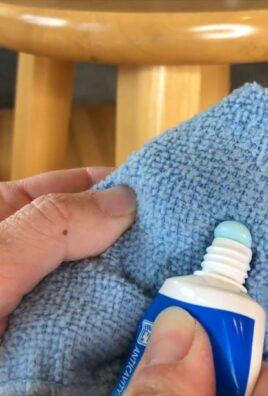
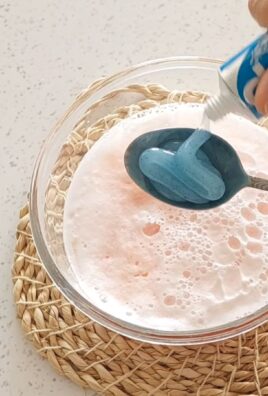
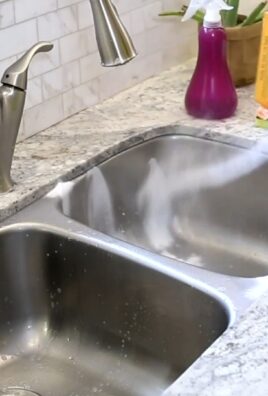
Leave a Comment